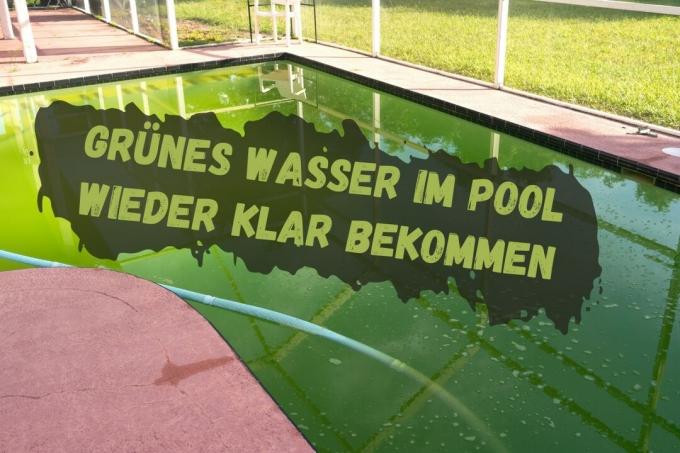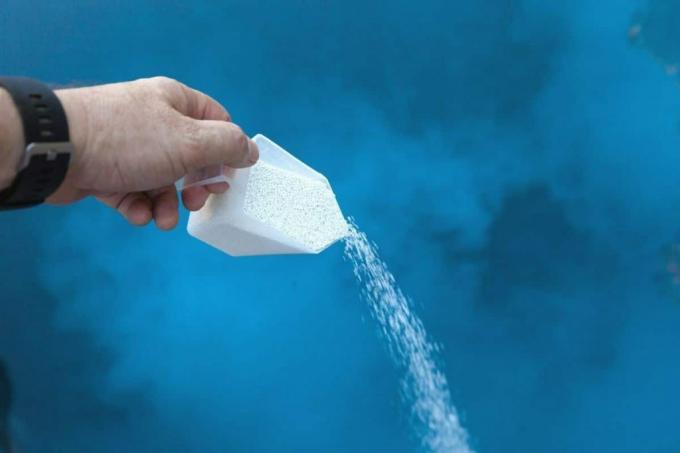
table of contents
- Green water: causes
- Regular testing
- Adjust the pH value
- Filter
- chlorine
- cover
- Nets
- cleaning
- Choice of location
- Frequently asked questions
If there is green water in the pool, it is not only visually problematic. This can also result in health risks. Simple steps and home remedies can help keep the pool clean.
In a nutshell
- green water can arise very quickly
- Cleaning is often time-consuming
- Home remedies are only partially gentle
- Filtering can prevent the problem
- Prevention is often the best solution
Green water: causes
When green water appears in the pool, algae are responsible. This not only makes the pool look unappealing. The floor and walls also become streaky and slimy. Among other things, this can lead to slipping when entering or leaving the pool. There are also other potential difficulties, such as:
- Skin irritation and irritation
- Tilting the water
- unpleasant smell
- complete algae
It is therefore crucial that the appropriate measures are taken. This should be done when the pool is set up. Just like regular cleaning.

Regular testing
The pH value of the water is crucial for the formation or growth of algae. It is ideal if the values lie between the following values:
- Alkalinity between 80 and 150 ppm
- Chlorine content about 3 ppm
- pH from 7.2 to 7.6
Note: Corresponding test kits can be found in specialist shops. However, a water sample can also be given to a hardware store or a pet shop, for example, in order to check the water values.
Adjust the pH value
if the pH values too acidic appropriate home remedies such as soda or a targeted pH plus agent can be used. If the values are too alkaline, however, it makes sense to use vinegar or citric acid.
In any case, further tests must be carried out continuously so that the correct area can be targeted and algae can be avoided.
Tip: One test a week with a corresponding test strip makes the adjustment easy. Because deviations are noticed early and the adjustment can be carried out gently.

Filter
One of the simplest forms of prevention is the correct filtering of the water in the pool. Various factors are required for this. These include, for example:
-
Cover: One of the most important preventive measures is to cover the pool. This prevents contaminants from falling into the pool.
-
Capacity: You must select the appropriate filter. Otherwise the algae can spread and form a streaky coating. It is better if the model has more capacity than there are liters in the basin. This allows you to keep the runtime of the device low.
-
UV light: The use of UV light in the pool filter ensures that the algae die off. The investment is therefore worthwhile and can prevent the unwanted growth from spreading in the long term.
- Changing the filter elements: Regular replacement prevents the filter from clogging and can make the use of other means unnecessary.
chlorine
Chlorine, for example in the form of tablets, can not only kill algae and thus prevent a green coating. The agent is also suitable for removing other impurities.
The application is quick and easy. Chlorine is available in different forms. The most common are tablets, which are very easy to dose. However, the agent can also be used in liquid form. It is important to ensure that the recommended dose is not exceeded. Otherwise skin and mucous membrane irritations can occur.
It is also important that so-called shock chlorination first takes place in the case of already heavily algae and very green water. This measure is chemical and anything but gentle, but it can be the last option. Otherwise the water must be completely replaced and the pool cleaned.
Corresponding products can be found on the market that make shock chlorination very easy.

cover
Covering the pool is one of the most important preventive measures against pollution and green water. Because leaves that fly in and other impurities contribute to the nutrient content, which in turn can promote the growth of algae. Another advantage of a tarpaulin is that this solution is not chemical.
Tip: Experience has shown that a precisely fitting cover is recommended. It also reduces the effort required for cleaning, is inexpensive and easy to use.
Nets
Leaves and other foreign bodies that have entered contribute to the fact that the pH value of the water can deviate from the desired range. It is therefore crucial to remove the dirt as quickly as possible. A landing net is ideal for this. Because at least coarse soiling can be removed quickly and easily with little effort.
It should be noted that the net should be as fine-meshed as possible. Although this increases the resistance during use, the cleaning effect also increases.
cleaning
Brushes that can be used manually are also an option, as is an automatically working robot. By removing the coverings, you also achieve a preventive effect. Thorough cleaning of the walls and floor or the liner should be carried out at least once a year when the pool is emptied. If the water is cloudy, the measure is required more often. The water can remain in the pool during this time, provided that the suspended matter can be removed from it afterwards.
For this purpose, for example, the nets and a high-performance filter are again suitable.
Note: When choosing the cleaning utensils concerned, you should make sure that they do not cause any damage to the surface. It is therefore crucial not to use too much pressure or too rough aids. Green water in the pool can also be avoided more quickly if it is cleaned more frequently.

Choice of location
The placement has a major influence on the maintenance effort. Places under trees or bushes run the risk of particularly large amounts of leaves falling into the water. Other foreign bodies and dirt can also be entered.
Free spaces that are not exposed to direct sunlight can also be suitable. The following factors are helpful:
- if necessary, use a close-meshed net as a cover
- do not choose places directly next to deciduous plants
- Avoid direct sunlight
Frequently asked questions
No, as long as the right measures are taken, the water will remain clear. A combination of cover, filter and possibly chlorine is usually sufficient to make swimming a pleasure and to prevent clouding and discoloration.
Even small remnants of earth, leaves or blades of grass can have a significant effect on the values of the water. Rinsing your feet can therefore ensure that the pool water stays clear longer.
Several causes can be responsible for this. These include, for example, insufficient filter capacity or lack of cleaning. A problem arises, especially when cleaning hard-to-reach areas. Because folds and grooves are predestined for further expansion. Special attention should therefore be paid to them.
